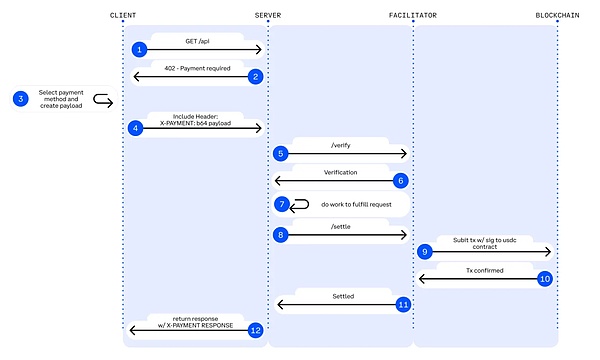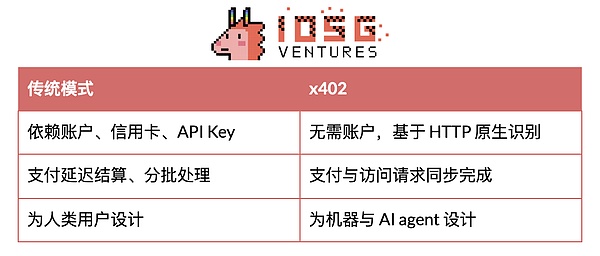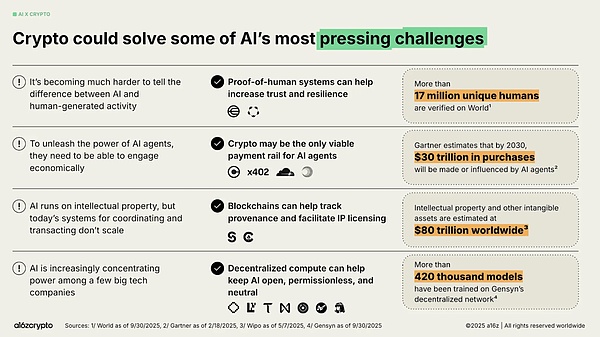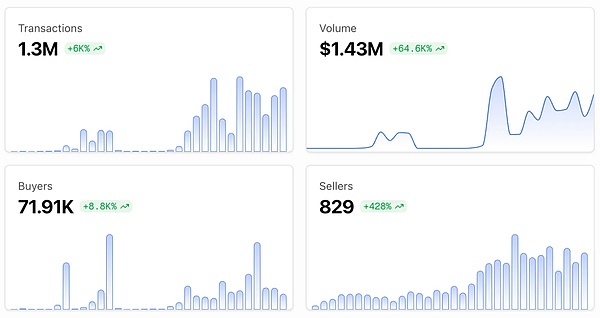Author|Figo @IOSG
The underlying architecture of the Internet was never born for "payment"
The Internet was originally designed to transmit information, not value. Protocols such as HTTP and DNS allow data to be transmitted instantly around the world, but they do not have a built-in native charging mechanism. HTTP reserves a status code 402 Payment Required to handle scenarios where payment is required for access, but because there was no machine-programmable, verifiable payment method at the time, this status code was shelved for over 30 years and was never actually used.
Result: A set of "patch-style" workarounds have been formed
In order to monetize content, developers have to overlay various external systems on the protocol layer:
Subscription accounts bound to credit cards
API Key model with monthly settlement
Advertising-based business model, where users pay indirectly with "attention or data"
These systems all assume that "users are human." They rely on registration, login, forms, and intermediaries and are not suitable for autonomous software or machines.
The internet is entering a phase where "software is the user."
We are entering a new usage paradigm: it's not people who make requests, but the software itself.
AI agents are independently requesting data, calling models, and performing tasks
Digital services are shifting from a subscription model to "pay-per-call," charging per API call, per inference, and per millisecond of computing power.
In this scenario, traditional payment methods (credit cards, account top-ups) are completely ineffective. What machines need is a "payment mechanism embedded in the protocol" to enable automatic settlement without human intervention. The internet already has the bandwidth for machine-to-machine communication; now it needs the native capability to conduct transactions between machines. The Emergence of x402: Activating the Internet's Native Payment Layer x402 is an open payment standard launched in 2025 that aims to formally activate the HTTP 402 status code, transforming it into an internet-native payment mechanism. Compared to traditional models that require account creation, credit card binding, or pre-top-up, x402 embeds payment requests directly into HTTP responses, allowing clients (whether human, robot, or AI agent) to automatically recognize payment information and complete settlement. In short, x402 allows a single HTTP request to have both "data transfer" and "value transfer" attributes. Once payment is completed, access rights are instantly granted, without the need for an account or manual operation.
x402's standardized interaction model
x402 defines three types of participants:
Client: The user, application, or AI agent that initiates the request
Server: The entity that provides data or services (API, website, etc.)
Facilitator: Responsible for verifying whether the payment is completed. Most current implementations are based on blockchain, but in theory any system with verifiable settlement capabilities can be connected
Basic process
The client requests a resource (e.g., GET /premium-data)
The server returns HTTP 402 with payment conditions (payment assets, amount, receiving address, etc.)
The client initiates payment using a stablecoin (e.g., USDC)
The settler verifies that the payment is complete
The client re-initiates the request and attaches proof of payment
The server returns data
This process is fully programmable and does not require human intervention or an account system.

▲ x402 payment process
(Source: x402 White Paper https://www.x402.org/x402-whitepaper.pdf )
The core difference between x402 and traditional models

Analogy: HTTPS It didn't create a new website, but it made secure communication a native capability of the internet. Similarly, x402 isn't a new application; rather, it brings payment down to the internet protocol layer, making the flow of value as fundamental to the internet as the flow of data. Why now, and what changes will it bring? The internet's underlying assumption has always been that users are human—they open browsers, log in to their accounts, and manually complete payments. However, this premise is failing. AI agents and automated systems are increasingly becoming active participants in the internet, autonomously requesting data, invoking services, and performing actions without the need for humans in the loop to approve every interaction. If these agents are to truly participate in the economy, they must not only be able to make requests but also to instantly and programmatically complete payments. Why this moment is a turning point: Several key technological trends are converging to create the conditions for the implementation of x402: Stablecoins have become the native currency of the internet, providing machines with a globally universal, programmable, and instantly settled payment asset. The emergence of low-cost Rollups and high-performance settlement chains has made the "pay-per-request" micropayment model economically viable, with transaction costs as low as one-thousandth of a cent.
AI agents are transforming from passive tools to active economic entities.
They can autonomously initiate transactions, purchase services, and create value.
Agent identity standards such as ERC-8004 and the introduction of protocols such as Google's AP2 provide agents with verifiable identities and transaction histories, enabling the network to identify "who is paying and why."
These trends together form the foundation for x402 to become a machine-native payment transport layer. The new model opened by x402: x402 enables value to flow freely on the internet like data. This means that payments no longer rely on human interaction or subscription models, but are oriented towards real-time machine-to-machine economic activities.
On-demand transactions for AI and APIs
Agents can pay per call to access data or models, without the need for API keys or pre-charges:
Autonomous infrastructure consumption
Computing power and storage are billed based on usage:

▲ Encryption solutions meet AI challenges
(Source: a16z《State of Crypto 2025》report https://a16zcrypto.com/posts/article/state-of-crypto-report-2025/ )
Key forces driving adoption
Cloudflare: Internet infrastructure integration
Cloudflare is integrating x402 Google has integrated its payment processing directly into its global edge network, allowing payment logic to be executed at the infrastructure layer rather than as application-layer code. Cloudflare also launched the NET Dollar, a USD stablecoin for machine-automated settlements with instant confirmation and global reach. Cloudflare has clearly stated that the next generation of business models on the internet will be based on micropayment interactions between agents. Google: Agent Payments Protocol (AP2) Google has launched the Agent Payments Protocol (AP2), enabling AI agents to initiate authentication, payment, and settlement operations across Web2 and Web3 environments. AP2 is inherently payment-neutral but natively supports encrypted payment extensions based on x402, making x402 the default settlement layer for the agent economy across Google Cloud, consumer applications, and enterprise services. Visa: Trusted Agent Protocol Visa has launched the Trusted Agent Protocol, designed to ensure that AI agents initiating payments can be verified, authorized, and associated with real user intent. Built in partnership with Cloudflare and aligned with x402, the protocol provides identity and trust infrastructure for mainstream compliance scenarios. Rapid Usage Growth x402 usage has accelerated over the past month as more services integrate the standard and autonomous agents prepare to initiate payments through x402 endpoints.
Last 30 days (data from x402scan):
Number of transactions: 1.35 million
Total payment volume: $1.48 million
Active paying agents: 72,150
Effective payment endpoints: 960
It’s worth noting that most of this growth occurred in the last 7

▲ x402 Global Statistics
(Past 7 days, source: x402scan https://www.x402scan.com/)
This wave of growth was primarily driven by speculative experiments based on x402 (such as minting tokens through x402 endpoints). Despite the speculative nature of these activities, they served as stress tests and significantly increased developer interest in x402 as a payment primitive. The prediction market has long focused on binary settlement, resulting in a significant reduction in information dimensionality. Future socially aware oracles will need to acquire more data sources and adopt dynamic models for comprehensive evaluation of different data types. After discussing DeFi projects related to Polymarket, I realized there's significant design potential for dynamic settlement data during market operations. This could support more sustained prediction markets, such as real-time, in-game trading for sports events. Continuous price markets or combinatorial markets like parlay offer significant opportunities, but currently, oracles don't support them. The x402 ecosystem is rapidly expanding, encompassing settlement service providers, infrastructure providers, agent platforms, and application services. This trend suggests that x402 is gradually becoming the infrastructure layer upon which other machine protocols are built. Outlook x402 is still in its early stages, and the current market interest in it is indeed somewhat speculative. But this short-term sentiment cannot obscure the underlying structural shift it represents: for the first time, payments can be implemented at the same protocol layer as data transmission, enabling autonomous intelligent agents to complete transactions natively on the internet without account systems, intermediaries, or human authorization. The long-term value of x402 lies not in the standard itself, but in the entire new infrastructure it enables: including agent identity standards, programmable wallets, low-latency settlement networks, and coordination protocols between machines. Regardless of whether x402 remains the ultimate payment standard in the future, it has already initiated an irreversible direction: the internet is evolving from "providing information to humans" to "a network where software drives economic activity."
 Kikyo
Kikyo







